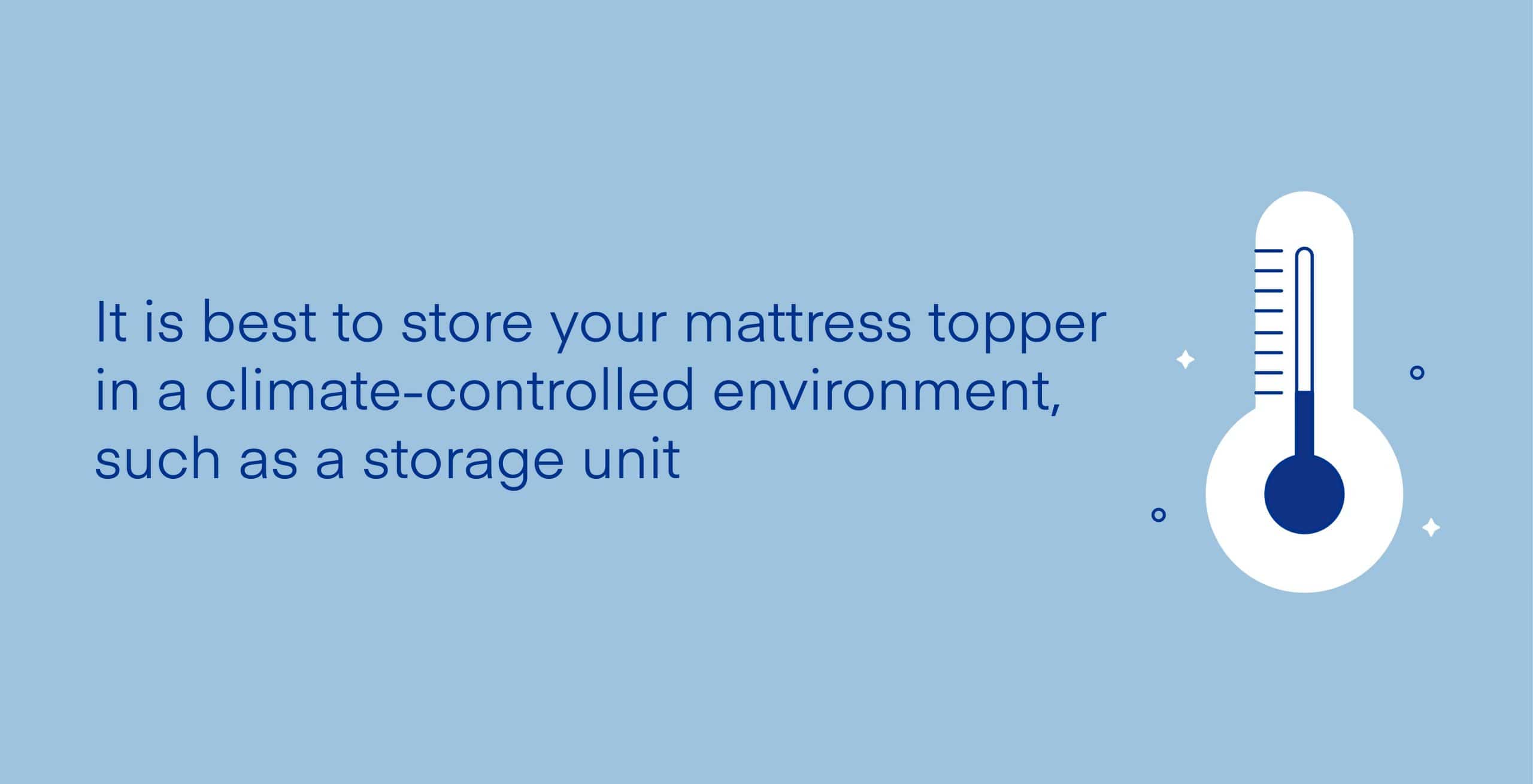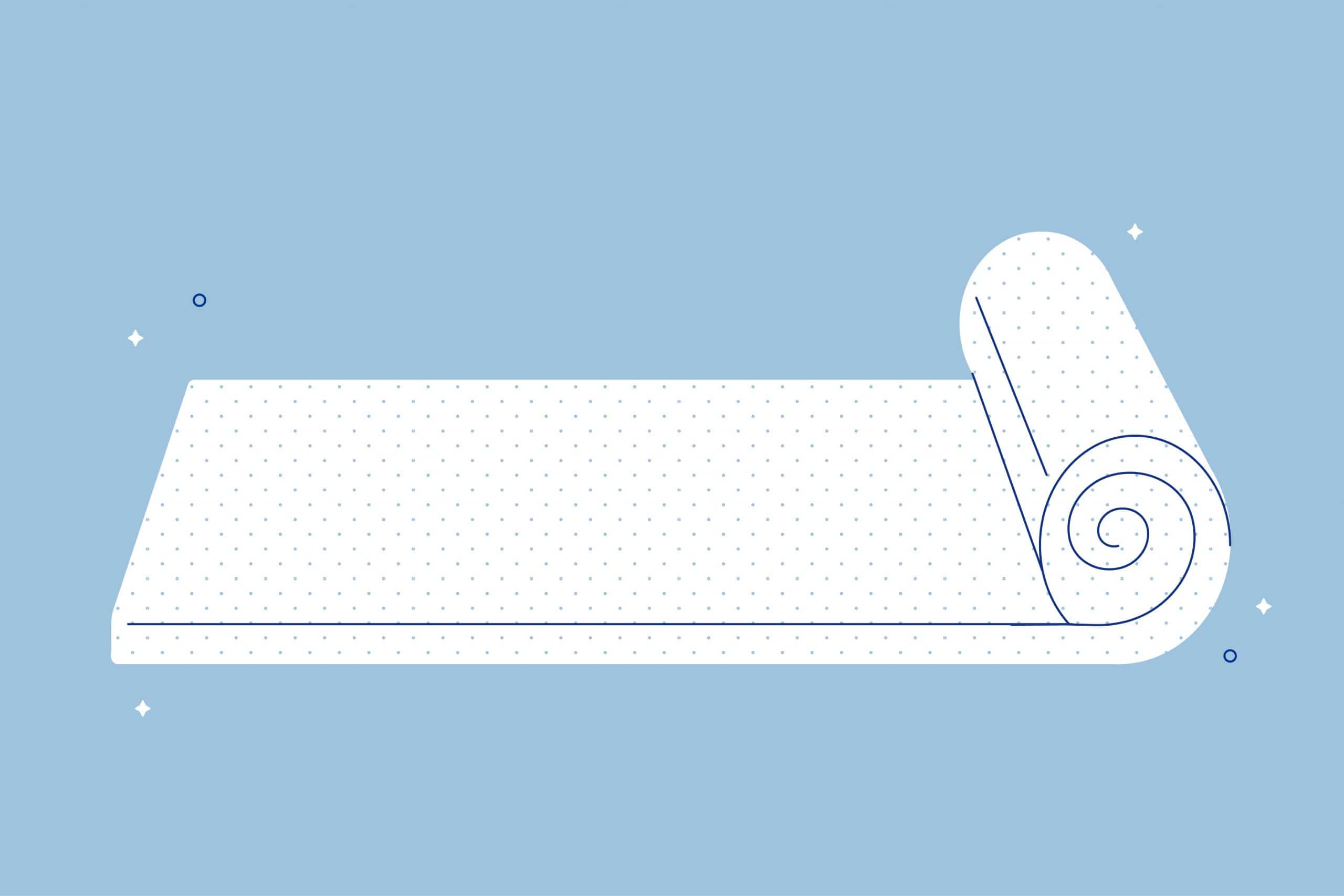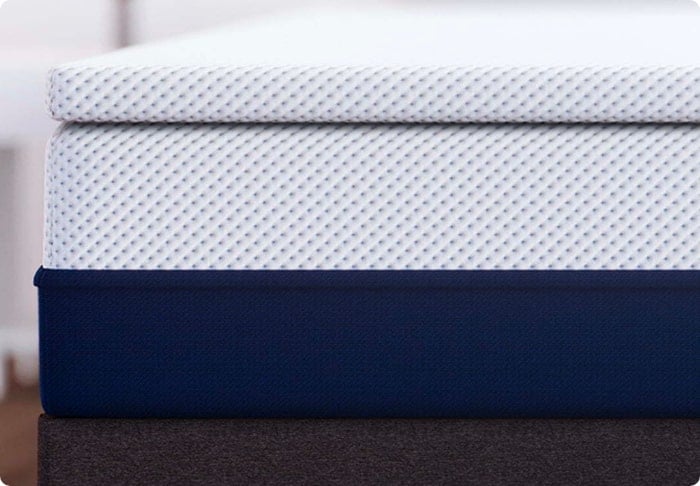Key Takeaways
- Clean and Dry: Before storing your mattress topper, clean it thoroughly by vacuuming to remove dust and debris. Spot-treat any stains with a mild detergent or stain remover. Allow it to air dry for 24 hours to ensure there is no moisture left. Cleaning ensures that dirt and bacteria do not become trapped during storage.
- Roll, Don’t Fold: When preparing your mattress topper for storage, roll it instead of folding it. Folding can cause cracks or permanent indentations in the foam, potentially damaging the topper. Rolling prevents creasing and long-term damage.
- Use a Protective Storage Bag: Place the rolled mattress topper in a high-quality storage bag, preferably a vacuum-sealed one. Vacuum-sealed bags save space and protect the topper from dust, dirt, dust mites, liquids, and other contaminants. Ensure the bag is securely sealed to prevent any moisture or pests from entering.
Mattress toppers are a great way to change the firmness of your mattress. If your bed is too soft, a medium to medium-firm topper can reduce sinking and spinal misalignment. If your bed is too firm, a soft topper can add some much-needed cushioning and comfort.
However, understanding the best way to store your mattress topper can often be a challenge. Like most bedding, proper storage will extend the life of your topper and ensure that it remains in good condition for many years. To help, we provide a step-by-step guide on the best way to store your mattress topper when it’s not in use.
Best Amerisleep Mattress Topper
Quick Guide: A 30-Second Summary
| Best Mattress Topper Overall | Amerisleep Lift™ Mattress Topper |
1. Cleaning and Drying
You should clean and dry your mattress topper before storing it away for an extended time. A thorough cleaning will ensure dirt and bacteria do not become trapped in the topper and cause permanent damage.
Below, we outline the best way to clean your mattress topper. These steps can help you safely clean a memory foam mattress topper or one made of latex foam.
How To Clean a Mattress Topper
- Remove bedding: Before cleaning your topper, be sure to remove all bedding, including sheets and mattress protectors.
- Vacuum: Using a vacuum cleaner with a hose attachment or a handheld vacuum, remove dust, dirt, debris, and other particles from the topper.
- Spot treat stains: If your topper has any stains, spot clean these areas with a mild liquid detergent or a stain remover. Gently work the stain out with a washcloth or soft-bristled brush, such as a toothbrush. Then, blot any remaining soap or water with a towel. Repeat this process until the stain is gone. Note: When cleaning your mattress topper, be mindful of the amount of water and liquid soap you pour directly onto the foam. If not removed properly, excess liquid can become trapped in the topper and cause mold and mildew to form.
- Odor treatment: With constant use, your mattress topper may develop an odor. To freshen it, sprinkle baking soda on the surface of the topper and let it sit for 1 to 2 hours before vacuuming it up. If you notice any powerful odors associated with a stain, spot treat this area with a paste made of baking soda and water. Rub this mixture into the topper and remove it with a clean, damp cloth.
- Air dry: Once you have thoroughly cleaned your topper, let it air dry for 24 hours. Be sure the topper is completely dry before storing it. If any moisture is left behind, it may cause mold and mildew growth. If you don’t use water or soap to clean your topper, you should still let it air out for at least a day before storing it.
2. Rolling
Once your mattress topper is completely clean and dry, it is time to roll it for storage. Rolling it makes the storage process easier and allows the topper to fit in most spaces.
However, be sure not to fold the mattress topper. Folding it could cause a crack or permanent indentation in the foam, rendering the topper useless. Rolling is the best way to prevent creasing and long-term damage.
3. Storing
Once the topper is rolled, you are ready to place it in a protective storage bag. A high-quality storage bag will ensure dust, dirt, dust mites, liquids, and other contaminants do not collect in the topper.
It is best to store your mattress topper in a vacuum-sealed bag. A vacuum storage bag will help you save space and protect your topper from damage. In most cases, the original packaging your topper came in has a vacuum seal, so it is a good idea to keep this bag for storage.
If you don’t have the original bag, you can use a large plastic mattress bag and seal it using your vacuum hose. If you don’t intend to vacuum seal your topper, wrap it in a protective plastic bag and secure the ends with duct tape.
4. Climate Control
It is best to store your mattress topper in a climate-controlled environment, such as a storage unit. These spaces are equipped with temperature and humidity control to keep them dry and cool throughout the year, reducing the risk of mold and mildew growth.
If you plan to store your topper in your home, be sure to choose a dry, moisture-free area, such as a bedroom closet. In general, it is best to avoid storing your topper in a basement or attic since these areas tend to be damp and humid. However, if you’ve remade your basement into a bedroom with climate control features, you may be able to store your topper safely away in a closet, trunk, or foot locker.
Why Use a Mattress Topper?
A mattress topper can be a valuable addition to a mattress for several reasons:
- First, it can provide an extra layer of comfort and cushioning, making a firm mattress feel softer or helping a new mattress causing back pain feel more comfortable.
- Second, a mattress topper can help improve the support of a mattress that is too soft or lessen the effect of mattress sagging, adding an extra level of support to promote proper spinal alignment.
- Finally, a mattress topper can serve as a protective barrier, helping to extend the lifespan of a mattress by shielding it from stains, spills, and general wear and tear. However, for the best protection, we recommend a mattress protector.
Overall, a mattress topper is a versatile and cost-effective solution for enhancing the comfort, support, and longevity of a mattress. However, sometimes you may wish to choose a new mattress instead of a topper. See also our guide to choosing between a mattress topper or new mattress.

Frequently Asked Questions
What is the best mattress topper for side sleepers?
When side sleeping, the hips and shoulders bear most of the body weight—this can cause pressure and tension to build-up in these areas. Therefore, side sleepers need a plush sleep surface that molds to the body for instant pressure relief. In most cases, the best mattress for a side sleeper is soft to medium. However, if your bed is too firm for side sleeping, you can add a soft to medium mattress topper to increase comfort and contouring.
What mattress topper is best for back pain?
If you have back pain, your spine must remain neutral during sleep. A healthy sleep position will allow the back muscles to relax, so healing can take place. To ensure a neutral spine, the hips should not sink too far into the mattress topper and force the spine to bow. Therefore, a medium to medium-firm topper is best for those with back pain.
Should you flip a memory foam mattress topper?
To keep your mattress topper from sliding, most brands include grips or ties on the bottom to secure it to the bed. Therefore, you may not be able to flip the topper. However, you should rotate the topper from head to foot (180 degrees) every few months to ensure even wear and tear.
How long should you keep a mattress topper?
Most high-quality mattress toppers, such as those made with memory foam or latex foam, last 3 to 5 years. Those made with poly-foam typically only last 1 to 2 years. The weight placed on the topper and frequency of use can also impact how long the topper will remain supportive.
What’s the difference between a mattress pad and a mattress protector?
Mattress protectors are designed to protect the mattress from stains, spills, and other accidents. They are typically waterproof and can also prevent bed bugs and allergens from collecting in the mattress.
A mattress pad is a thin layer of cotton or wool used to add comfort to the mattress. However, they don’t offer protection against spills.
Conclusion
Mattress toppers are a great way to customize the comfort and support of your bed. However, it may not be something that you plan to use regularly. For example, you may want to keep one where you store bedding for guests.
Whenever you are ready to store your topper, the steps above will ensure that it remains in good condition and is always ready to use.
About the author
April Mayer is a sleep expert and writer with a degree in exercise physiology. She has dedicated her career to exploring the relationship between sleep and productivity. Her insightful articles, such as "The Surprising Way Your Mood Might Be Messing With Your Productivity" and "Wake Up to More Productive Mornings," have been featured in reputable publications like Forbes, Greatist, Real Homes, Thrillist, Tom's Guide, and Eat This, Not That. With a passion for helping others lead more productive lives through restful sleep, April offers valuable expertise on foods and vitamins for better sleep. As a trusted member of the Early Bird team since March 2020, she continues to provide informative and well-researched content.
View all posts





